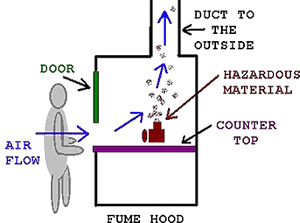Contact Info
Location
Ohio Wesleyan University
61 S. Sandusky St.
Delaware, OH 43015

A fume hood is a type of local ventilation device that is designed to limit exposure to hazardous or toxic fumes, vapors or dusts.
The primary parts of the fume hood are:
Variable Air Volume (VAV) – VAV hoods maintain a constant velocity as the sash moves but changes the volume of air. This can be done by a variety of methods including changing motor speed or closing or opening baffles in the duct. This is desirable since lower sash heights results in less air being used, which translates into substantial energy savings on heating and cooling.
Standard or Bypass –With standard hoods the volume of air changes as the sash moves so that as the sash is lowered the velocity increases. Bypass hoods are the same design but have a vent in the top so that as the sash is lowered and the sash opening is closed, it simultaneously opens the top (bypass) vent. In this way, even though the sash opening is getting smaller, the proportion of air volume flowing through the face is smaller and the velocity remains more constant. This does not save as much energy as a VAV hood, but performs better than a standard hood.
Auxiliary Air – These hoods not only draw air but also have a blower that injects air at the face of the hood. These hoods are no longer used much on campus and their performance is not as good as VAV and bypass hoods.
Ductless hoods – These hoods are not ducted to outside air but remove contaminants from the air and return it back to the room. The contaminants may be removed by a variety of means such as HEPA air filters, carbon adsorption or catalyst reactions filters. The filters should be changed on a schedule according to the manufacturer and the appropriate filter should be used for the particular contaminant being removed. It is vital that these units work properly since the air is reticulated and exposure is eminent. It is recommended that ductless hoods not be purchased unless the benefits outweigh the hazards and inconvenience because potential for problems. Also, ductless hoods are not indicated when using many liquid, non-aqueous chemicals since the vapors of these chemicals are heavier than air and ductless hoods do not generally have a rear baffle. As a general rule EH&S does not recommend the use of ductless hoods.
Clean hoods – Clean hoods are sometimes called laminar hoods. These hoods are safety devices designed to bath the work area with HEPA filtered air to protect sensitive processes from contamination. They are commonly used in clean rooms. These hoods draw the majority of air through a filter and drop the air gently from the top of the hood into the work area and draw only a small percentage of air through the face of the hood (about 10%). The result is face velocities that are lower than other hoods, however, the hood is designed to capture well in this fashion.
 A fume hood confines hazardous airborne material by diluting it with a large amount of air drawn in from the front (open) side of cabinet through an exhaust system, and either expelled outside of the building or made safe through filtration and fed back into the room. The front is a sash window, usually in glass, able to move up and down on a counterbalance mechanism.
A fume hood confines hazardous airborne material by diluting it with a large amount of air drawn in from the front (open) side of cabinet through an exhaust system, and either expelled outside of the building or made safe through filtration and fed back into the room. The front is a sash window, usually in glass, able to move up and down on a counterbalance mechanism.
Sash should be closed when experiments are not in progress or whenever the hood is on and unattended.
Keep chemicals at least 6 inches back from the edge of the air foil sill.
Bring the hood's door down at least 2/3 of the way when working with the hood. (The sash, in combination with the bypass grille located above the sash, determines the airflow characteristics of the fume hood. The sash position controls the velocity of air that passes through the fume hood, influencing chemical vapor capture. Placing the sash at the lowest level for convenient operation will provide the best protection)
The velocity of the fume hood should be greater than 80 fpm for the use with non-carcinogen chemicals. If carcinogens are being used, the face velocity must be greater than 150 fpm.